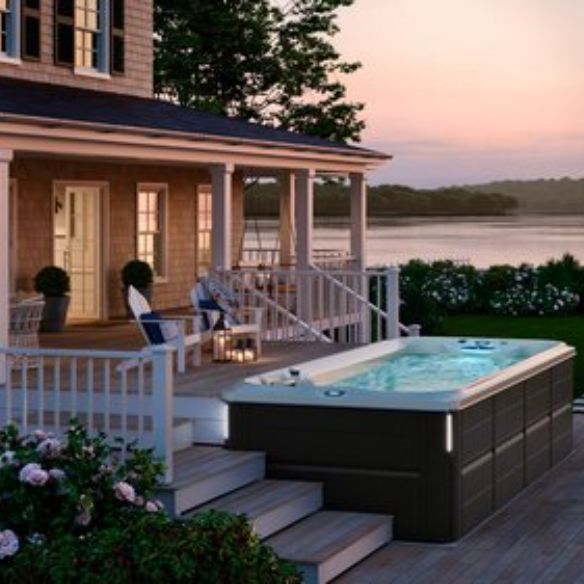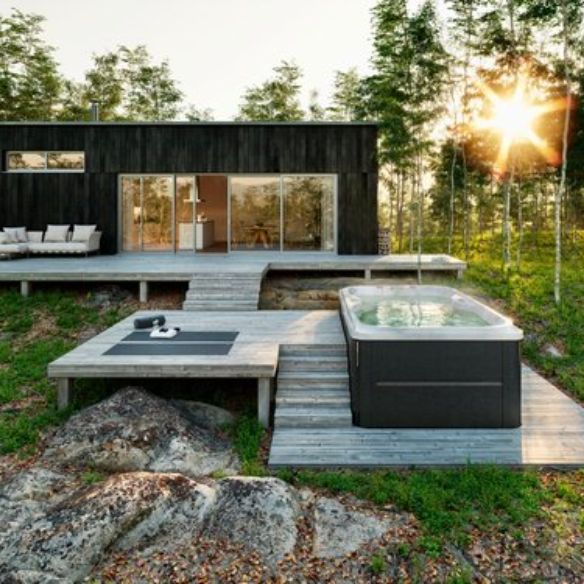Welcome to your ultimate guide on swim spas. Whether you're seeking to understand the concept, trying to differentiate between a swim spa and a hot tub, or pondering over the best way to install one, you've come to the right place. We'll also tackle some frequently asked questions such as, "Can you really swim in a swim spa?" and "Do you need planning permission for a swim spa in the UK?"

What is a Swim Spa and How Does it Work?
A swim spa, as the name suggests, combines the features of a swimming pool and a hot tub. It is essentially a compact, self-contained pool that allows you to swim against a steady current produced by powerful jets. With the current's speed adjustable, you can easily modify your workout intensity, making it an excellent choice for fitness enthusiasts and those seeking aquatic therapy.
But how does a swim spa work? The swim spa generates a current through a propulsion system, which can either be a jet propulsion or a paddlewheel system. The jet propulsion system utilises high-powered jets to push water into the swimming area, while the paddlewheel system creates a flow of water. The current's strength and speed can be adjusted to accommodate the swimmer's skill level and desired workout intensity.
Can You Really Swim in a Swim Spa?
Yes, you absolutely can! The idea behind a swim spa is to allow you to swim continuously against a water current, thus you can get a workout similar to swimming laps in a full-sized pool, but in a fraction of the space. This feature, often referred to as "swim-in-place," is ideal for swimmers of all levels. Beginners can learn and practice in a safe, controlled environment while advanced swimmers can challenge themselves with stronger currents.
And if it's good enough for Adam Peaty to swim in, it's good enough for us too!

Swim Spa vs Hot Tub: What’s the Difference?
While both swim spas and hot tubs have therapeutic jets and can be heated, they serve different primary functions. A hot tub is primarily designed for relaxation and hydrotherapy, with seating areas and various jet configurations to target different muscle groups. The water temperature typically ranges from 37-40°C, which is significantly warmer than a swim spa.

On the other hand, a swim spa is designed for both exercise and relaxation. It provides a strong current to swim against and often includes a separate area for hydrotherapy and relaxation. The water temperature in a swim spa is usually cooler to facilitate comfortable workouts, typically around 26-30°C, but can be increased for relaxation and therapeutic purposes.
What is the Ideal Temperature for Swimming in a Swim Spa?
As mentioned earlier, the ideal temperature for swimming in a swim spa is generally between 26-30°C. This cooler water allows for vigorous exercise without causing you to overheat. However, the perfect temperature may vary depending on your personal comfort and the type of exercise or therapy you're doing. For those using the swim spa for low-intensity exercise or relaxation, slightly higher temperatures may be preferred.
Installing a Swim Spa: Above Ground or In-Ground?
Swim spas can be installed either above ground or in-ground. Above ground installation is simpler, faster, and more cost-effective. It also makes access to the spa’s mechanical components easier for maintenance and repairs. However, they can be somewhat obtrusive and may not blend quite as seamlessly with your garden.
In-ground installation, while more costly and time-consuming, offers an aesthetically pleasing result as the spa is flush with the ground and can be landscaped to fit your garden design. However, this method can make accessing the spa's mechanical components more difficult.



Do You Need Planning Permission for a Swim Spa in the UK?
Typically, in the UK, swim spas, like other garden structures, do not require planning permission as they are considered 'permitted development.' However, if you live in a listed building or a designated area (like a conservation area), it's worth checking with your local planning authority. Always ensure you're fully informed before commencing any installation project.
Swim Spa Maintenance
Maintenance is crucial to keep your swim spa running optimally and to ensure a clean, safe swimming environment. This includes regular water testing and chemical treatment to balance pH levels and prevent bacteria and algae growth.
Additionally, the spa’s filter should be cleaned regularly, and the water should be completely replaced every 3-4 months. The cover should also be maintained, as it helps insulate the spa, maintain water temperature, and prevent debris from entering the water.
Advantages of a Swim Spa over a Swimming Pool
There are several reasons why you might prefer a swim spa over a traditional swimming pool.
- Space-Saving; Swim spas take up less space, perfect for smaller gardens.
- Year-Round Use; Swim spas are heated and can be used all year round, unlike many outdoor pools.
- Versatility; They offer the dual benefit of swimming exercise and relaxation with therapeutic jets.
- Lower Maintenance; They require less water, making them more environmentally friendly and cheaper to maintain than full-sized pools.
- Ease of Installation; Swim spas are self-contained, making them easier to install than traditional swimming pools.
Swim spas represent a versatile and compact option that can meet many of the recreational and therapeutic needs typically met by larger swimming pools or hot tubs. By understanding how they work, how they can be used, and what the installation entails, you can make an informed decision about whether a swim spa is the right choice for you.
Of course, if you do have any more questions, feel free to get in touch with our team at !

